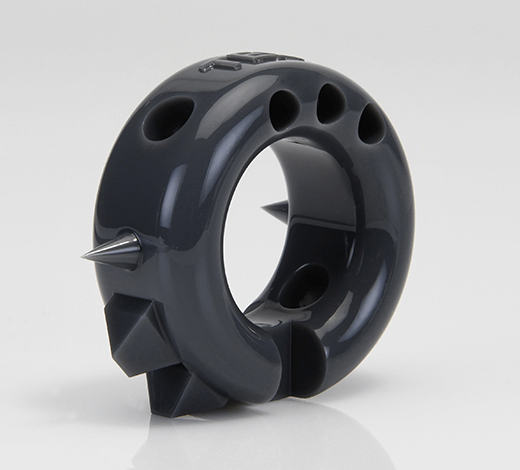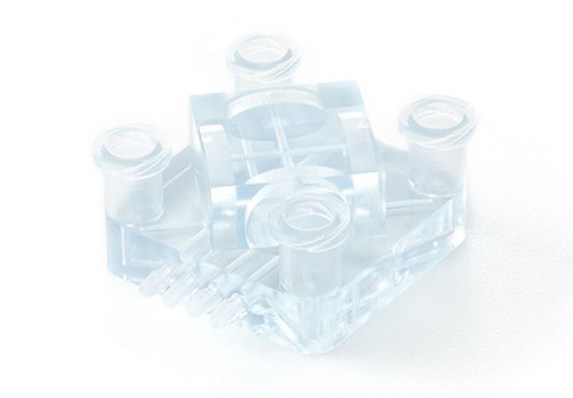
Stereolithography (SLA) Resin 3D Printing Service
SLA 3D printing service for rapid prototyping. Multiple thermoset resin materials available. Get an instant online quote.
Certification + Compliance
ISO 9001:2015 | ISO 13485:2016 | AS9100D | ITAR
Jump to Section
→ Capabilities
→ SLA Materials
→ Surface Finishes
→ Post Processing Options
→ Our SLA 3D Printers
→ Why Choose SLA 3D Printing?
What is Stereolithgraphy?
Stereolithography (SLA) is a 3D printing process used to create concept models, cosmetic prototypes, and complex parts with intricate geometries. It's an additive manufacturing technology that forms parts by curing thermoset resin with a UV laser. A wide selection of materials, extremely high feature resolutions, and quality surface finishes are possible with SLA.
SLA 3D printing is primarily used for:
- parts requiring high accuracy and features as small as 0.002 in.
- good surface quality for cosmetic prototypes
- form and fit testing
Stereolithography (SLA) Design Guidelines and Capabilities
Our basic guidelines for stereolithography include important design considerations to help improve part manufacturability, enhance cosmetic appearance, and reduce overall production time.
*Available for the following materials: ABS-Like White and Gray, and ABS-Like Translucent/Clear.

SLA Material Options
ABS-Like White (Accura Xtreme White 200)
expand_less expand_moreABS-Like White (Accura Xtreme White 200) is a widely used general purpose stereolithography material. In terms of flexibility and strength, this material falls between molded polypropylene and molded ABS, which makes it a good choice for functional prototypes. Parts as large as 29 in. x 25 in. x 21 in. can be built with ABS-Like White so consider it a primary option if you require an extensive part size build envelope.
Primary Benefits
- Durable, general purpose resin
- Accommodates extra-large parts
ABS-Like Gray (Accura Xtreme Gray)
expand_less expand_moreABS-Like Gray (Accura Xtreme Gray) is a widely used general purpose stereolithography material. In terms of flexibility and strength, this material falls between molded polypropylene and molded ABS, which makes it a good choice for functional prototypes. ABS-Like Gray offers the highest HDT of the ABS-like SLA resins.
Primary Benefits
- Durable, general purpose resin
- Highest HDT of the ABS-like SLA resins
ABS-Like Black (Accura 7820)
expand_less expand_moreABS-Like Black (Accura 7820) is a widely used general purpose material. Its deep black color and glossy up-facing surfaces in a top profile offer the appearance of a molded part, while layer lines may be visible in a side profile. Accura 7820 also has low moisture absorption (0.25% per ASTM D570) so that parts are more dimensionally stable. Compared to other materials used for stereolithography, it has midrange values for all mechanical properties.
Primary Benefits
- Low moisture absorption
- Glossy cosmetic appearance
ABS-Like Translucent/Clear (WaterShed XC 11122)
expand_less expand_moreABS-Like Translucent/Clear (WaterShed XC 11122) offers a unique combination of low moisture absorption (0.35% 0.25% per ASTM D570) and near-colorless transparency. Secondary operations are required to achieve functional part clarity, and the part will also retain a very light blue hue afterward. While good for general-purpose applications, WaterShed is the best choice for flow-visualization models, light pipes, and lenses.
Primary Benefits
- Lowest moisture absorption of SLA resins
- Functional transparency
MicroFine™ (Gray and Green)
expand_less expand_moreMicroFine™ is a custom formulated material available in gray and green that is exclusive to Protolabs. This ABS-like thermoset is printed in Protolabs’ customized machinery to achieve high resolution features as small as 0.002 in. MicroFine is ideal for small parts, generally less than 1 in. by 1 in. by 1 in. In terms of mechanical properties, MicroFine falls in the mid-range of stereolithography materials for tensile strength and modulus and on the low end for impact strength and elongation.
Primary Benefits
- Produces highest resolution parts
- Ideal for extra-small parts
PP-Like Translucent White (Somos 9120)
expand_less expand_morePP-Like Translucent White (Somos 9120) is the most flexible SLA option outside of Carbon RPU 70 and FPU 50. In direct comparison to the average values of an injection-molded polypropylene, 9120 has similar tensile strength, tensile modulus, flexural modulus, and impact strength. The only departure from molded PP is its elongation value, which is only 25% of the molded thermoplastic.
Primary Benefits
- Semi-flexible
- Translucency
PC-Like Advanced High Temp (Accura 5530)
expand_less expand_morePC-Like Advanced High Temp (Accura 5530) creates strong, stiff parts with high temperature resistance. A thermal post-cure option can increase HDT as high as 482°F at 0.46 MPa loading. Accura 5530 has the highest E-modulus of all the unfilled SLA materials, and it is known for being resistant to automotive fluids. However, the thermal curing process does make Accura 5530 less durable, resulting in a 50% reduction to elongation.
Primary Benefits
- High elastic modulus
- Higher resistance to heated fluids
PC-Like Translucent/Clear (Accura 60)
expand_less expand_morePC-Like Translucent/Clear (Accura 60) is an alternative to the general purpose ABS-like materials and WaterShed XC 11122 when stiffness is desired. Like WaterShed, this material can be custom finished to achieve functional transparency with secondary processing. Accura 60 has the highest tensile strength of and elastic modulus compared of all stereolithography materials outside of the Advanced High Temp options that are most often thermal cured.
Primary Benefits
- High stiffness
- Functional transparency
Ceramic-Like Advanced HighTemp (PerFORM)
expand_less expand_moreCeramic-Like Advanced HighTemp (PerFORM) exhibits the highest tensile strength and E-modulus making it the stiffest performance material of the SLA materials. When the thermal cure option is applied to parts made from PerFORM, it exhibits the highest HDT (as high as 514°F at 0.46 MPa loading) of the SLA materials.
Primary Benefits
- Stiffest SLA resin
- Highest HDT of SLA resins
True Silicone
expand_less expand_moreTrue silicone is 100% pure silicone that is available in different shore-A hardness as detailed below. The material is suitable to produce both functional prototypes and end-use products. The material shows high resistance to harsh environments conditions, various acids, bases and nonpolar solvents.
Compare SLA Material Properties
| Material | Color | Tensile Strength | Tensile Modulus | Elongation |
|---|---|---|---|---|
| ABS-Like White (Accura Xtreme White 200) |
White | 7.9 ksi | 479 ksi | 9% |
| ABS-Like Gray (Accura Xtreme Gray) |
Gray | 5.8 ksi | 290 ksi | 9% |
| ABS-Like Black (Accura 7820) |
Black | 7.0 ksi | 435 ksi | 5% |
| ABS-Like Translucent/Clear (WaterShed XC 11122) | Translucent/Clear | 7.9 ksi | 421 ksi | 6% |
| MicroFine™ (Gray and Green) |
Gray or Green | 8.7 ksi | 377 ksi | 8% |
| PP-Like Translucent White (Somos 9120) | Translucent/White | 5.0 ksi | 232 ksi | 25% |
| PC-Like Translucent/Clear (Accura 60) | Translucent/Clear | 10.8 ksi | 508 ksi | 7% |
| PC-Like Advanced High Temp* (Accura 5530) | Translucent/Amber | 6.5 ksi | 566 ksi | 1.5% |
| Ceramic-Like Advanced HighTemp* (PerFORM) |
White | 10.9 ksi | 1,523 ksi | 1% |
| True Silicone | Translucent White | 0.711 ksi | n/a | >1,000% |
*Properties listed are based on thermal cure
| Material | Color | Tensile Strength | Tensile Modulus | Elongation |
|---|---|---|---|---|
| ABS-Like White (Accura Xtreme White 200) |
White | 54.47 Mpa | 3300 Mpa | 9% |
| ABS-Like Gray (Accura Xtreme Gray) |
Gray | 39.98 Mpa | 2000 Mpa | 9% |
| ABS-Like Black (RenShape SL7820) |
Black | 48.26 Mpa | 3000 Mpa | 5% |
| ABS-Like Translucent/Clear (WaterShed XC 11122) | Translucent/Clear | 54.47 Mpa | 2600 Mpa | 6% |
| MicroFine™ (Gray and Green) |
Gray or Green | 59.98 Mpa | 2600 Mpa | 8% |
| PP-Like Translucent White (Somos 9120) | Translucent/White | 34.47 Mpa | 1600 Mpa | 25% |
| PC-Like Translucent/Clear (Accura 60) | Translucent/Clear | 74.46 Mpa | 3503 Mpa | 7% |
| PC-Like Advanced High Temp* (Accura 5530) | Translucent/Amber | 44.81 Mpa | 3902 Mpa | 1.5% |
| Ceramic-Like Advanced HighTemp* (PerFORM) |
White | 75.15 Mpa | 10,500 Mpa | 1% |
| True Silicone | Translucent White | 4.9 Mpa | n/a | >1,000% |
*Properties listed are based on thermal cure
These figures are approximate and dependent on a number of factors, including but not limited to, machine and process parameters. The information provided is therefore not binding and not deemed to be certified. When performance is critical, also consider independent lab testing of additive materials or final parts.
Surface Finish Options for SLA Parts
|
|
|
| Unfinished | Dots, or standing "nibs," remain evident on the bottom of the part from the support structure remnants. Good for when fast lead times are required or cost is a factor |
| Natural | Supported surfaces are sanded down to eliminate the support nibs. |
| Standard | Supported surfaces are sanded, and the entire part is finely blasted for a consistent look. Note that the layers are still present. |
| Custom | Soft-touch paint, clear part finishing, painting, masking, color matching, decals/graphic, and texture finishes are available. |

Material: ABS-like Translucent/Clear
Finish: Unfinished

Material: MicroFine Gray™
Finish: Unfinished

Material: ABS-like Translucent/Clear
Finish: Standard

Material: MicroFine Gray™
Finish: Standard

Material: ABS-like Translucent/Clear
Finish: Natural

Material: MicroFine Gray™
Finish: Natural

Material: ABS-like Translucent/Clear
Finish: Custom

Material: MicroFine Gray™
Finish: Custom

Metal Plating
Our metal-plating process for SLA coats a ceramic-filled PC-like material (Somos PerFORM) with a nickel that gives parts the look, feel, and strength of metal, but without the weight. The combination of the material’s strength, rigidity, and temperature resistance with nickel plating, takes strength, stiffness, and impact and temperature resistance to a degree previously unattainable in SLA parts.

Microfluidics
Our microfluidic fabrication process is a modified form of high-resolution SLA that uses a clear ABS-like material (WaterShed XC 11122). Parts are resistance to water and humidity, and work well for lens and flow-visualization models.
Our SLA 3D Printers
Our stereolithography machines consists of Vipers, ProJets, and iPros. In high-resolution mode, Vipers and ProJets can make parts with extremely tiny features and crisp details, while in normal-resolution mode, they can build cost-effective parts very quickly.
iPros have extremely large build volumes at 29 in. by 25 in. by 21 in. (736mm by 635mm by 533mm), yet are still able to image highly detailed parts easily.

Why Use SLA?
Stereolithography (SLA) is an additive manufacturing process that can 3D print parts with small features, tight tolerance requirements, and smooth surface finishes.
How Does SLA 3D Printing Work?
The SLA machine begins drawing the layers of the support structures, followed by the part itself, with an ultraviolet laser aimed onto the surface of a liquid thermoset resin. After a layer is imaged on the resin surface, the build platform shifts down and a recoating bar moves across the platform to apply the next layer of resin. The process is repeated layer by layer until the build is complete.
Newly built parts are taken out of machine and into a lab where solvents are used to remove any additional resins. When the parts are completely clean, the support structures are manually removed. From there, parts undergo a UV-curing cycle to fully solidify the outer surface of the part. The final step in the SLA process is the application of any custom or customer-specified finishing. Parts built in SLA should be used with minimal UV and humidity exposure so they don’t degrade.
Additional Resources About Stereolithography (SLA)

Get an instant online quote for 3D printing.











